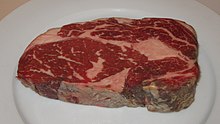


Marbled meat is meat that contains various amounts of intramuscular fat, giving it an appearance similar to marble. The term is principally applied to red meat.
Key terms
Beef quality grades - are based on a composite evaluation of the degrees of (1) marbling and (2) maturity. These designations reflect carcass firmness, texture, and color of lean, and the amount and distribution of marbling within the lean. High grades represent high projected levels of tenderness, juiciness, and flavor.
Marbling - is the intermingling or dispersion of intramuscular fat within the lean. Graders evaluate the amount and distribution of marbling in the ribeye muscle at the cut surface after the carcass has been ribbed between the 12th and 13th ribs. Degree of marbling is the primary determination of quality grade.
Maturity - refers to the physiological age of the animal rather than the chronological age. Because the chronological age is virtually never known, physiological maturity is used; the indicators are bone characteristics, ossification of cartilage, and the color and texture of ribeye muscle. Cartilage becomes bone, lean color darkens and texture becomes coarser with increasing age. Cartilage and bone maturity receives more emphasis because lean color and texture can be affected by other postmortem factors.
Beef yield grades - estimate the amount of boneless, closely trimmed retail cuts from the high-value parts of the carcass–the round, loin, rib, and chuck. However, they also show differences in the total yield of retail cuts. A YG 1 designation indicates a carcass having the highest percentage of boneless, closely trimmed retail cuts, or higher cutability, while a YG 5 carcass would have the lowest of each.
The USDA Yield Grades are rated numerically from 1 to 5, with 1 denoting the highest yielding carcass and 5 the lowest.
United States grading system
The USDA's grading system, which has been designed to reward marbling, has eight different grades (listed in descending order):
- Prime
- Choice
- Select
- Standard
- Commercial
- Utility
- Cutter
- Canner.
Prime is the premium grade, has the highest marbling content, and fetches the highest prices at restaurants and supermarkets. Choice is most commonly sold in retail outlets, and Select is sold as a cheaper option in many stores.
Prime, Choice, Select and Standard grades commonly come from younger cattle (under 42 months of age); Commercial, Utility, Canner and Cutter are applied to older cattle carcasses which are not marketed as wholesale beef sides or blocks, and are used in ground products and for cheaper steaks in family chain restaurants.
See also
- Artificial marbling
- Boston butt – A cut of pork
- Jamón ibérico – Type of cured pork leg product
- List of steak dishes
References
- ^ "USDA Beef Quality and Yield Grades". Meat Science. Archived from the original on 2021-06-27. Retrieved 2015-04-22.
- U.S. Meat Animal Research Center, ARS, USDA (September 9, 1994). "Effect of Marbling Degree on Beef Palatability in Bos taurus and Bos indicus Cattle" (PDF). USDA. Archived (PDF) from the original on May 15, 2013. Retrieved September 17, 2006.
{{cite web}}: CS1 maint: multiple names: authors list (link)
| Meat | |||||
|---|---|---|---|---|---|
| Poultry |   | ||||
| Livestock | |||||
| Game | |||||
| Fish | |||||
| Shellfish and other seafood | |||||
| Insects | |||||
| Cuts and preparation |
| ||||
| List articles |
| ||||
| Ethics and psychology | |||||
| Alternatives | |||||
| Meat science | |||||
| Meat industry | |||||
| Related subjects | |||||
| This article needs additional or more specific categories. Please help out by adding categories to it so that it can be listed with similar articles. (November 2024) |